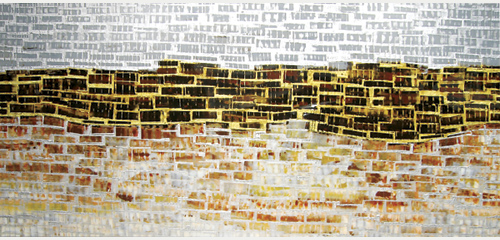
At once a foreigner in Los Angeles and a resident there for half her life, Gisela Colon is also a born painter. But, until recently, she was a stranger to the art world--a largely self-taught talent able to manifest her vision skillfully through unusual combinations of material. Born in Canada and raised in her father's native Puerto Rico, Colon's German mother was a landscape painter, but Colon herself studied economics and law and worked for legal firms in Southern California until she could no longer ignore the artistic impulse. In its dramatic conflation of contrasting modes, however, the kind of art Colon has produced embodies the polarities of her life. Indeed, as she says, Colon considers her work a "synthesis of two diverse and distinct influences: Latin American modern abstract art and North American aesthetics that are seminal to the West Coast region."
By her own admission, Colon's art is "earthy and sensual," but also rigorous and ordered. She identifies such a dialectical distinction as particular to art of the Western Hemisphere, whether practiced by Latin American artists such as Jesus Raphael Soto and Wifredo Lam, by New York artists such as David Smith and Mark Rothko, or by artists associated with "Light and Space" in Los Angeles such as Ron Davis and Craig Kauffman. "Geometric abstraction is the primary source of my artistic vocabulary," Colon notes, "and lends intellectual reasoning to my work... I like to think I create objects that possess a vibrant 'Latin spirit' contained in a light-imbued 'California skin' yet are structured by a universal visual language that coalesces into a new form."
Colon has discussed "the idea that the intellectual basis of geometric abstract art (at least in Latin America, and specifically in my childhood experience in Caribbean Latin America) stems from a need for order, precision, symmetry in response to the environmental instability, chaos, and tumultuous existence of everyday life." Even as Colon achieves a condition of balance, however, it refuses to be merely ordered, precise, and symmetric, throbbing instead with an opulent vivacity. Fabricated to function at once as images and objects, Colon's paintings present themselves both as self-contained spaces and as things occupying space--another dialectical condition that ties her to abstract practices equally in Latin America and in California.
"The purpose of my work," Colon declares, "is to create 'architecture,' compositions with a structural and architectural quality." She describes her painting process as "in and of itself a 'construction' of sorts, an additive and reductive process of building layer upon layer of paint with knives," seeking "the contrast between the paintings' formal rigor and the lustrous beauty of their surface." Throughout her career Colon has refined her practice in pursuit both of this contrast and of the architectonic reasoning that supports it, until, in her most recent work, the Chromo-Saturation series, "orderly layers of colored bands, blocks, and geometric forms" result in "an 'architecture' of color and light."
Colom's approach, then, is a painterly geometry--not simply the realization of composition through the use of soft-edged grids, but the determination of ordered, reasoned form with inarguably manual, organic gestures. As opposed to the Modernist ideal of a geometric art rendered by machines, Colon's is a geometric art rendered quite obviously by a human. The impetus for the work is rational, but the manufacture of the work is inflected with character, a potential for almost mercurial change. Colon achieves not simply a balance between chaos and order, but a fusion of passion and reason, volatility and coherence--a synthesis of dialectical polarities that betrays its dual sources.
"Raw Geometry" a three person show including works by Gisela Colon will be on view from August 6 - September 12, at Madison Gallery, in La Jolla. www.madisongalleries.com
"Gisela Colon: Chromatic Cool," a solo show of Colon's work, could be seen from March 12 - April 20, 2011, at Andi Campognone Projects, in Pomona, CA. http://andicampognone.com
This article was written for and published in art ltd. magazine ![]()
